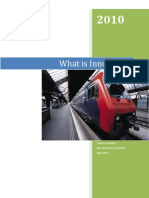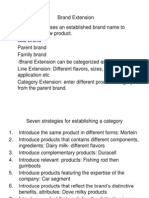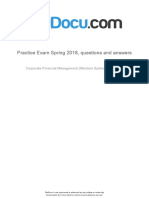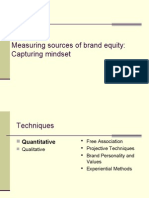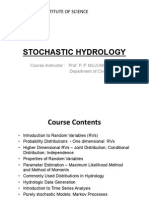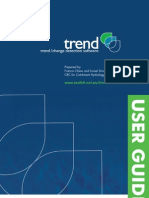Oliver Grasl-Business Model Dynamics
Oliver Grasl-Business Model Dynamics
Uploaded by
kardraCopyright:
Available Formats
Oliver Grasl-Business Model Dynamics
Oliver Grasl-Business Model Dynamics
Uploaded by
kardraCopyright
Available Formats
Share this document
Did you find this document useful?
Is this content inappropriate?
Copyright:
Available Formats
Oliver Grasl-Business Model Dynamics
Oliver Grasl-Business Model Dynamics
Uploaded by
kardraCopyright:
Available Formats
2010 transentis management consulting GmbH & Co. KG www.transentis.com 1 www.transentis.
com
A model & simulation driven approach
isee User Conference 2010 Making Connections
Dr. Oliver Grasl, 5. October 2010
BUSINESS MODELS: STRUCTURE & DYNAMICS
2010 transentis management consulting GmbH & Co. KG www.transentis.com 2 2010 transentis management consulting GmbH & Co. KG www.transentis.com 2
The business model concept
What business models are not about
A business model construction kit
Business model blueprints
Case Study: Dynamics of a professional service firm
2010 transentis management consulting GmbH & Co. KG www.transentis.com 3 2010 transentis management consulting GmbH & Co. KG www.transentis.com 3
1 The business model concept
2 What business models are not about
3 A business model construction kit
4 Business model blueprints
5 Case Study: Dynamics of a professional service firm
2010 transentis management consulting GmbH & Co. KG www.transentis.com 4
Transformation
STANDING STILL IS NOT AN OPTION
Business Model
Organization
Technology
S
t
r
u
c
t
u
r
e
s
P
r
o
c
e
s
s
e
s
High market expectations
Intense competition
New value chains
Disruptive Technologies
Mergers & Acquisitions
An enterprise
External drivers (such as market expectations, competition, new technologies)
force enterprises to implement changes to their business models an
operations standing still is not an option.
2010 transentis management consulting GmbH & Co. KG www.transentis.com 5
IMPORTANT STRATEGIC QUESTIONS
How do we shape strategic initiatives within our firm?
How do we position our firm towards our stakeholders?
How do we create value for our stakeholders?
How will we change our firm by implementing strategic initiatives?
How shall we monitor and assess the progress of our strategic
initiatives?
Mller-Stewens/Lechner 2005
2010 transentis management consulting GmbH & Co. KG www.transentis.com 6
BUSINESS MODEL ENGINEERING FOCUSES
ON VALUE CREATION
How do we shape strategic initiatives within our firm?
How do we position our firm towards our stakeholders?
How do we create value for our stakeholders?
How will we change our firm by implementing strategic initiatives?
Business models address the question of value creation, or:
"How do we make money in this business?"
How shall we monitor and assess the progress of our strategic
initiatives?
Mller-Stewens/Lechner 2005
2010 transentis management consulting GmbH & Co. KG www.transentis.com 7
GENERAL DEFINITION OF BUSINESS MODEL
A firm's business model shows how it creates value for all the parties
within its value network (customers, shareholders, business partners)
by defining its value logic and showing which products and services
are exchanged between these parties.
Magretta 2002, Timmers 1998,
Zott/Amit 2007
2010 transentis management consulting GmbH & Co. KG www.transentis.com 8
WHY BUSINESS MODELS ARE IMPORTANT
In future business model innovation will be the key to generating
new wealth: Competition no longer takes place between
companies and products, but between business models.
Hamel 2000
In future business model innovation will be more important
for business success than product innovation.
Kagermann/
sterle 2006
2010 transentis management consulting GmbH & Co. KG www.transentis.com 9
WHY IS BUSINESS MODEL ENGINEERING
HARD?
The business model concept is a fairly fuzzy concept that
is not used consistently.
It hard to evaluate business models quantitatively,
because many assumptions are not made explicit.
Business is not static, but highly dynamic it is difficult
to make quantitative predictions about dynamic systems
using simple calculations.
The ownership of the business model and the value creation
policies within an enterprise is often unclear nobody feels
responsible for the big picture.
Grasl 2008
2010 transentis management consulting GmbH & Co. KG www.transentis.com 10
WHY IS BUSINESS MODEL ENGINEERING
USEFUL?
Clarlfylng Lhe value proposluon and re-deslgnlng Lhe buslness model
Lo supporL lL.
Assesslng Lhe vlablllLy of a new buslness ldea by maklng
all assumpuons expllclL and explorlng poLenual rlsks and
opporLunlues.
Maklng Lhe buslness model LransparenL Lo all sLakeholders,
ln a quallLauve and quanuLauve way.
verlfy exlsung pollcles, and ndlng new pollcles, LhaL wlll lmprove
value creauon and Lhus Lhe overall success of Lhe buslness.
Creaung a learnlng envlronmenL for Lhose ln Lhe rm LhaL have Lo
puL new or changed buslness pollcles lnLo eecL.
2010 transentis management consulting GmbH & Co. KG www.transentis.com 11 2010 transentis management consulting GmbH & Co. KG www.transentis.com 11
1 The business model concept
2 What business models are not about
3 Business model construction kit
4 Business model blueprints
5 Example: Exploratory model of a professional service firm
2010 transentis management consulting GmbH & Co. KG www.transentis.com 12
BUSINESS MODELS ARE CONCERNED
WITH VALUE CREATION
How do we create value for our stake holders?
Customers
Focal Firm
Suppliers
Business models are concerned with
creating value within a value network.
2010 transentis management consulting GmbH & Co. KG www.transentis.com 13
BUSINESS MODELS ARE NOT CONCENERED
WITH VALUE APPROPRIATION
How do we position our firm towards our stake holders?
Value appropriation is the concern of a firms positioning
strategy.
Competitor
Competitor
Competitor
Competitor
Competitor
Focal Firm
2010 transentis management consulting GmbH & Co. KG www.transentis.com 14
BUSINESS MODELS ARE NOT CONCERNED
WITH VALUE DELIVERY
How do we deliver value efficiently?
Business
Process
Focal Firm
Value delivery is the concern of a firms operations.
2010 transentis management consulting GmbH & Co. KG www.transentis.com 15 2010 transentis management consulting GmbH & Co. KG www.transentis.com 15
1 The business model concept
2 What business models are not about
3 A business model construction kit
4 Business model blueprints
5 Example: Exploratory model of a professional service firm
2010 transentis management consulting GmbH & Co. KG www.transentis.com 16
THE VALUE CREATION CONCEPT
Value
created
Willingness-to-pay
Price
Cost
Opportunity Cost
Buyer's share
Firm's share
Supplier's share
Addressed by the
firms value
proposition
Addressed by the
firms business model
The concept of value creation is important because it distinguishes
effectiveness ("Are we creating the right products?") from efficiency
("Are we creating the products in a cost effective way?").
Value = Benefits - Costs
Brandenburger/Stuart 1996
2010 transentis management consulting GmbH & Co. KG www.transentis.com 17
DEFINITION OF BUSINESS MODEL
A firm's business model shows how it creates value for all the parties within
its value network by defining its value logic and showing which products and
services are exchanged via transactions between these parties.
Business Model Value Network
Transaction Model
Value Logic
Grasl 2009b
2010 transentis management consulting GmbH & Co. KG www.transentis.com 18
BUSINESS MODELS AND
ENTERPRISE ARCHITECTURE
Business Strategy
Value Realization Business Operations
Value Appropriation Product-Market Strategy
Value Creation Business Model
Business Processes
Applications & Technology
Business models are situated within the strategy layer of an enterprise's
architecture.
Grasl 2009b
2010 transentis management consulting GmbH & Co. KG www.transentis.com 19
BUSINESS MODEL: VALUE NETWORK
Supplier
Focal Firm
Capabilities
Policies
Assumptions
Customer
The value network shows which channels a firm provides to connect
the parties in the product and factor markets.
Channel
Grasl 2009b
2010 transentis management consulting GmbH & Co. KG www.transentis.com 20
BUSINESS MODEL: TRANSACTION MODEL
The transaction model shows which transactions are supported or enabled
via the channels of the value network, and which products and artifacts are
exchanged during these transactions.
Channel
Transaction
Resources
Cost Revenue
Transaction
Products Supplier
Focal Firm
Capabilities
Policies
Assumptions
Customer
Grasl 2009b
2010 transentis management consulting GmbH & Co. KG www.transentis.com 21
BUSINESS MODEL: VALUE LOGIC
Sales cost
Value added
Customers
Revenue
Capabilities
Investments
Resources
Products
Cash
The value logic shows how resources and capabilities are used to support
transactions, create products, attract customers and drive value creation
in a self sustaining feedback loop.
Grasl 2009b
2010 transentis management consulting GmbH & Co. KG www.transentis.com 22
FULL BUSINESS DYNAMICS
Revenue
Sales Cost
Products
Investments
Market Size
Customers
Capabilities
Cash
Value
added
Markets served
Operations Resources
Operating Expenses
Debt
Operating Income
Prices
Competitors
Business dynamics =
value dynamics ! market dynamics ! operational dynamics
2010 transentis management consulting GmbH & Co. KG www.transentis.com 23
BUSINESS MODEL BUILDING BLOCKS
Resource Capability
Asset
Role
Artifact
Role
Channel
Core construct
Transaction
Core construct
Party
Role
Market
Core construct
Value
Core construct
Product
Role
Service
Good
Price
Transaction
cost
Channel cost
Cost
Needed to
produce
Needed to
produce
Needed to
provide
Creates Operates in
+ Customer
+ Customer
+ Provider
Provides
+ Supplier
Supported by
Exchanged
via
Exchanged via
+ Transaction
price
+ Product price
0 *
1 *
1 *
1 * 1 *
1 *
1
1 *
This model
illustrates
the core
constructs
relevant
to analyzing
and designing
business models
Grasl 2009b
2010 transentis management consulting GmbH & Co. KG www.transentis.com 24
BUILDING BLOCKS EXPLAINED
Asset
Artefact
Party
Channel
Product
Value
Transaction
Generally, an artifact is something created by a human for a practical purpose. Specifically in this
context, an artefact is anything exchanged during a transaction besides the products themselves,
examples being a proposal or a product description sheet.
The term "asset" is used as a generalization for resources and capabilities. An asset is a resource
(e.g. physical property, intangible right) or capability that has economic value. Important
examples are plant, equipment, land, patents, copyrights, and financial instruments such as
money or bonds. A firm needs assets to enable its transactions, maintain channels and create
its products.
A channel is a conduit by which a firm offers its products.
These products are exchanged via a transaction.
Any legal entity engaged within the business model. Examples for other parties besides firms
are public authorities and public households.
A product is any good or service produced by a business. Businesses are characterized by
the fact that they produce goods or service beyond their own need and can therefore offer
them to other parties via a market.
Firms interact via boundary spanning transactions, which are supported or enabled by channels.
A transactions takes place when a product is exchanged via a separable interface.
The value created by the firm. A general definition is "Benefits-Cost".
In practice this is frequently measured by the Free Cash Flow or Gross Margin
2010 transentis management consulting GmbH & Co. KG www.transentis.com 25 2010 transentis management consulting GmbH & Co. KG www.transentis.com 25
1 The business model concept
2 What business models are not about
3 A business model construction kit
4 Business model blueprints
5 Example: Exploratory model of a professional service firm
2010 transentis management consulting GmbH & Co. KG www.transentis.com 26
LEVELS OF DETAIL AND COMPLEXITY
View business at different levels of abstraction.
Generic Specific
Abstract
Detailed
Firm-specific value logic
(Business unit level)
Firm-specific value logic
(enterprise level)
Industry-specific
value logic
Generic value logic
Detailed simulation
model
Adapted from Winter 2003
2010 transentis management consulting GmbH & Co. KG www.transentis.com 27
BUSINESS MODEL BLUEPRINT: INDUSTRY SPECIFIC
Consulting firm value network
A consulting firm is a firm in which professional skills form the basis of its
services to customers. The services are characterized by a high degree of
customization and client contact.
Recruiting
Agency
Consulting
Partner
University
Business
Contact
Consulting firm Customer
Know
how
Junior
consultants
Leads
Profes-
sional
services
Grasl 2008
2010 transentis management consulting GmbH & Co. KG www.transentis.com 28
BUSINESS MODEL BLUEPRINT: INDUSTRY SPECIFIC
Consulting firm value logic blueprint
Cash
Customers
Know how
Talent
Recruiting
Knowledge
Management
Innovation
Marketing
Rode 2001
2010 transentis management consulting GmbH & Co. KG www.transentis.com 29
BUSINESS MODEL BLUEPRINT:
INDUSTRY SPECIFIC
Further Consulting firm constructs
Artefact Proposals
White Papers and Case Studies
Consulting Contracts
Asset
Product
Consultants
Partners
Freelance consultants
Channel Sales Channel
Marketing Channel
Recruitment Channel
Consulting Projects
Sell projects
Deliver projects
Hire and fire (freelance) consultants
Maintain business contacts
Maintain customer
Transaction
Value Fee Cash Flow
Gross Margin
2010 transentis management consulting GmbH & Co. KG www.transentis.com 30
BUSINESS MODEL BLUEPRINT: INDUSTRY SPECIFIC
eBusiness Full service provider value network
Supplier
<< Party >>
Supplier 1
<< Party >>
Supplier 2
<< Party >>
Supplier 3
<< Party >>
Full service Provider
<< Party >>
Customer
<< Party >>
Partial Service
<< Channel >>
Partial
Service
<< Channel >>
Partial Service
<< Channel >>
Product information
Full service delivery
Customer Relations
Sales
<< Channel >>
<< Channel >>
<< Channel >>
<< Channel >>
The full-service provider aims to meet the complete needs of a target
customer segment in one domain by integrating the firm's own products
and services with those of selected third party providers.
Weil/Vitale 2001
2010 transentis management consulting GmbH & Co. KG www.transentis.com 31
BUSINESS MODEL BLUEPRINT: INDUSTRY SPECIFIC
eBusiness full service provider value logic
Membership fees
Suppliers
Customers
Cash
Orders
Product
price
Full Service
Provider
Product Portfolio
Market
Presence
Supplier Pro-
duct Portfolio
Grasl 2009b
2010 transentis management consulting GmbH & Co. KG www.transentis.com 32
BUSINESS MODEL BLUEPRINT:
INDUSTRY SPECIFIC
Further eBusiness constructs
Artefact Oder Summaries
Invoices
Asset IT infrastructure
Product management capability
Relationship management capability
Brand management
Channel Marketing
Order
Delivery
Customer Relations
Supplier Management
Bulling
Product Books
CDs
Clothes
Search for products
Order products
Fulfill order
Send invoice
Transaction
Value Gross margin
2010 transentis management consulting GmbH & Co. KG www.transentis.com 33 2010 transentis management consulting GmbH & Co. KG www.transentis.com 33
1 The business model concept
2 What business models are not about
3 A business model construction kit
4 Business model blueprints
5 Case Study: Dynamics of a professional service firm
2010 transentis management consulting GmbH & Co. KG www.transentis.com 34
CONTEXT
Case study based on work carried out for a professional
service firm focusing on IT consulting.
1,100 employees worldwide
70 employees in Germany subsidiary
Participants were the CEO, CFO and Head
of Business Development.
The company has a very stable history of financial success
but is dissatisfied with growth rates.
Policy changes are hard to find and enforce in such conditions.
Grasl 2009a
2010 transentis management consulting GmbH & Co. KG www.transentis.com 35
KEY KPI'S FOR PROFESSIONAL SERVICE
FIRMS ("MAISTER KPI'S")
Maister 1997
Health factor
Standardization
Health factor
Innovation and
Specialization
Hygiene factor
Cost reduction
Hygiene factor
Sales and delivery
management
2010 transentis management consulting GmbH & Co. KG www.transentis.com 36
WHAT THE PSFS PARTNERS DO
Partners are responsible for the following activities:
Generating repeat business through client maintenance
New customer acquisition
Project delivery
Recruitment and consultant development
Development of new consulting products
2010 transentis management consulting GmbH & Co. KG www.transentis.com 37
VALUE LOGIC: FIRM SPECIFIC, CONCEPTUAL
Conceptual value logic of this professional service firm
At this professional service firm, the partners have to share their time
between customer acquisition, project delivery and customer maintenance.
Repeat
Projects
Customer main-
tenance required
Partner Customer
maintenance effort
Customers
First time
projects
Projects
Contacts
New
Project
Acquisition
Repeat
Project
Acquisition
Customer
maintenance
Partners
Partner Con-
tacting Effort
Contacting
effort required
Contact
Maintenance
Project effort
required
Project delivery
effort available
Project
Delivery
Consultants
Recruitment
Consultants Pro-
ject delivery effort
Partners Project
Delivery effort
2010 transentis management consulting GmbH & Co. KG www.transentis.com 38
STRATEGIC QUESTION
How should partners spend their time?
Which organizational policies should be followed to ensure
value and leverage are maximized?
2010 transentis management consulting GmbH & Co. KG www.transentis.com 39
THREE SCENARIOS
Scenario 1
Base Case
Partners spend up to 50% of their time in project delivery
The other 50% go to customer development and innovation
No time for standardization
Scenario 2
Concentrate
on the
customer
Scenario 3
Innovate and
standardize
Project delivery is delegated to senior and junior consultants
Partners focus on customer development and innovation
Partners focus more on standardization and less on innovation
2010 transentis management consulting GmbH & Co. KG www.transentis.com 40
SCENARIO 1
BASE CASE
Scenario 1 Maister KPIs
2010 transentis management consulting GmbH & Co. KG www.transentis.com 41
SCENARIO 2
CONCENTRATE ON THE CUSTOMER
Scenario 2 Maister KPIs
2010 transentis management consulting GmbH & Co. KG www.transentis.com 42
SCENARIO 3
INNOVATE AND STANDARDIZE
Scenario 3 Maister KPIs
2010 transentis management consulting GmbH & Co. KG www.transentis.com 43
GROSS MARGIN COMPARISON
Gross Margin Comparison
2010 transentis management consulting GmbH & Co. KG www.transentis.com 44
RECOMMENDATIONS
FROM SIMULATION STUDY
Shift partner effort stronger towards customer acquisition
and maintenance and away from project responsibilities.
Define concrete effort allocation policies
and monitor effort allocation.
Increase leverage by standardizing innovative consulting products.
Reconsider top-heavy partner structure
The real value of the model was in providing
a testbed for policy experiments.
Monitor the effect of innovation on fee structure.
2010 transentis management consulting GmbH & Co. KG www.transentis.com 45
SUMMARY
The question "How do we create value for all our stakeholders"
is fundamental to any enterprise.
An enterprise's value-creation logic is captured
in its business model.
It is important to understand the policies governing
the value creation process and to manage them explicitly.
Using a model-driven, visual approach to business model
engineering is useful to create shared understanding
of relevant policies across departments and hierarchies.
2010 transentis management consulting GmbH & Co. KG www.transentis.com 46
LITERATURE
Brandenburger, A. and H. Stuart (1996): Value based business strategy. Journal of Economics and Management Strategy 5, 5 25
Grasl, O. (2008): Business modelanalysis. In Systems Dynamics Society (Ed.), Proceedings of the 26
th
International Systems Dynamics
Conference. Athens, Greece
Grasl, O. (2009a): Key performance indicators in professional service firms a dynamic perspective. In Systems Dynamics Society (Ed.),
Proceedings of the 27
th
. International Systems Dynamics Conference. Albuquerque, USA
Grasl, O. (2009b): Professional Service Firms: Business Model Analysis Method and Case Studies, 2009. University of St. Gallen
Hamel, G. (2000): Leading the revolution. Harvard Business School Press
Kagerman, H.; sterle, H. (2006): Geschftsmodelle 2010 Wie CEOs Unternehmen transformieren. Frankfurter Allgemeine Buch
Magretta, J. (2000): Why business models matter. Harvard Business Review 2002, 3336
Maister, D. (1997): Managing the Professional Service Firm (First Free Press Edition ed.). Free Press Paperbacks
Mller-Stewens, G and C. Lechner (2005): Strategisches Management Wie strategische Initiativen zum Wandel fhren. Schffer-Pschel
Rode, N. (2001): Wissensmarketing Strategische Entscheidungsoptionen fr Anbieter von Wissen. Gabler
Timmers, P. (1998): Electronic Commerce: Strategies and Models for Business-to-business Trading. J. Wiley
Weill, P. and M. Vitale (2001): Place to Space - Migrating to e-Business Models. HBS Press
Winter, R. (2003): Modelle, Techniken und Werkzeuge im Business Engineering. In H. sterle and R. Winter (Eds.),
Business Engineering Auf dem Weg zum Unternehmen des Informationszeitalters (2
nd
ed.). Springer
Zott, C. and R. Amit: The fit between product market strategy and business model: implications for firm performance.
Strategic Management Journal, 1 26
2010 transentis management consulting GmbH & Co. KG www.transentis.com 47
Dr. Oliver Grasl
Managing Director
Partner
E-Mail: oliver.grasl@transentis.com
Mobil: +49 (0)173 6 54 67 27
2010 transentis management consulting GmbH & Co. KG www.transentis.com 48 www.transentis.com
transentis management
consulting GmbH
Kranzplatz 5 6
D-65183 Wiesbaden
www.transentis.com
Tel.: +49 (0)611-90099-51
Value creation in complex systems
New ways of creating value, transforming business
and aligning the organization.
You might also like
- A Stepmother's MarchenDocument1,171 pagesA Stepmother's Marchengyorfiboroka73% (11)
- IEEE 33-Bus Test Distribution SystemDocument2 pagesIEEE 33-Bus Test Distribution Systemkardra86% (21)
- 35 ChatGPT Prompts To Prep For Your Next Job InterviewDocument5 pages35 ChatGPT Prompts To Prep For Your Next Job Interviewneerajbhayal3456No ratings yet
- 26 Questions On Finance Answered 2Document10 pages26 Questions On Finance Answered 2208322 Popoola Ibrahim INDUSTRIALNo ratings yet
- Wallmart Project ReportDocument26 pagesWallmart Project ReportN-aineel Desai79% (24)
- Lionbridge JobDocument8 pagesLionbridge JobNew Top Music VideosNo ratings yet
- Lab 3 Mapping Stock and Flow and Metal SimulationDocument10 pagesLab 3 Mapping Stock and Flow and Metal SimulationPard TeekasapNo ratings yet
- 2012 Spring MKTG 3143.10 AshleyDocument12 pages2012 Spring MKTG 3143.10 AshleyVirendra MahechaNo ratings yet
- Compromise Agreement Rommel Cawaing Eli Cardinez and Robert TriaDocument4 pagesCompromise Agreement Rommel Cawaing Eli Cardinez and Robert TriaJaime GonzalesNo ratings yet
- Do Not Open Until Instructed To Do So: Math 2131 Final Exam Thursday, April 12th 180 MinutesDocument11 pagesDo Not Open Until Instructed To Do So: Math 2131 Final Exam Thursday, April 12th 180 MinutesexamkillerNo ratings yet
- Competitive Advantage, Firm Performance, and Business ModelsDocument72 pagesCompetitive Advantage, Firm Performance, and Business ModelsRetno TitisariNo ratings yet
- The Role of Kpis and Metrics in Digital Marketing: January 2019Document7 pagesThe Role of Kpis and Metrics in Digital Marketing: January 2019Nora MedalyNo ratings yet
- Accenture Strategy ZBX X Factor POV PDFDocument11 pagesAccenture Strategy ZBX X Factor POV PDFmanupedNo ratings yet
- What Is InnovationsDocument12 pagesWhat Is Innovationstanveer_buitems100% (1)
- Dull-Gelinas Chapter 4Document41 pagesDull-Gelinas Chapter 4Richard Dan Ilao ReyesNo ratings yet
- Tutorial Workbook 2019Document48 pagesTutorial Workbook 2019KriswantoNo ratings yet
- Porters ModelDocument24 pagesPorters ModelAsim jawedNo ratings yet
- CA IPCC Cost Accounting Theory Notes On All Chapters by 4EG3XQ31Document50 pagesCA IPCC Cost Accounting Theory Notes On All Chapters by 4EG3XQ31Bala RanganathNo ratings yet
- Presentation - Reinventing You Business ModelDocument20 pagesPresentation - Reinventing You Business Modelyunus_starkNo ratings yet
- Operations ManagementDocument17 pagesOperations Managementalm27phNo ratings yet
- Asset Performance MetricsDocument10 pagesAsset Performance MetricsRogelio SotoNo ratings yet
- 2nd Chapter Business PlanDocument104 pages2nd Chapter Business PlanNebil AregaNo ratings yet
- Sales Force ActivitiesDocument47 pagesSales Force ActivitiesVicky YuanNo ratings yet
- INDIA11 - 01B - Digital Business Platforms Integrating Your Busin - 315798Document42 pagesINDIA11 - 01B - Digital Business Platforms Integrating Your Busin - 315798Abhsihek100% (1)
- Valuing Bonds: Fundamentals of Corporate FinanceDocument27 pagesValuing Bonds: Fundamentals of Corporate FinanceShagufta MazharNo ratings yet
- CH 05 Creating Customer Value Satisfaction and LoyaltyDocument47 pagesCH 05 Creating Customer Value Satisfaction and LoyaltyMohsin KamalNo ratings yet
- Corporate Level Strategies: Dr. Nishikant C. Warbhuwan Ph. D. Mba (HRM) Be (It)Document166 pagesCorporate Level Strategies: Dr. Nishikant C. Warbhuwan Ph. D. Mba (HRM) Be (It)Salil BoranaNo ratings yet
- Chapter 8 Final Presentation-4Document31 pagesChapter 8 Final Presentation-4api-269676361100% (1)
- Theme 3: Understanding MKT Session 8: Consumer BehaviorDocument30 pagesTheme 3: Understanding MKT Session 8: Consumer BehaviorSiddharth SetiaNo ratings yet
- Brand ExtensionDocument12 pagesBrand ExtensionWaseem AsgharNo ratings yet
- Brand Equity MeasurementDocument16 pagesBrand Equity MeasurementGazal GuptaNo ratings yet
- Chapter 2 - The Concept of Value AdditionDocument20 pagesChapter 2 - The Concept of Value AdditionpeterNo ratings yet
- Strategic Marketing 01Document22 pagesStrategic Marketing 01Muhammad AliNo ratings yet
- CHAPTER 2 - Entrepreneurial Ideas and Opportunities LATESTDocument48 pagesCHAPTER 2 - Entrepreneurial Ideas and Opportunities LATESTdedeq_12No ratings yet
- Lot Sizing: (Heuristic Approach)Document16 pagesLot Sizing: (Heuristic Approach)Abdullah Al NomanNo ratings yet
- Project Analysis and Evaluation: Mcgraw-Hill/IrwinDocument40 pagesProject Analysis and Evaluation: Mcgraw-Hill/IrwinKazi Hasan100% (1)
- Firm Expo Business Model DevelopmentDocument22 pagesFirm Expo Business Model Developmentapi-255943481No ratings yet
- What Is Intrapreneurship?: Entrepreneur IntrapreneursDocument4 pagesWhat Is Intrapreneurship?: Entrepreneur IntrapreneursMohsin KamalNo ratings yet
- Individual AssignmentDocument8 pagesIndividual AssignmentpradeepNo ratings yet
- 412 33 Powerpoint-Slides Chapter-1Document18 pages412 33 Powerpoint-Slides Chapter-1Kartik KaushikNo ratings yet
- How To Make SME Segment ProfitableDocument35 pagesHow To Make SME Segment ProfitableTariq HasanNo ratings yet
- Group Assignment - Financial AnalysisDocument4 pagesGroup Assignment - Financial AnalysisAN THÁI THỊ THANHNo ratings yet
- Strategic Brand Management-A Case StudyDocument9 pagesStrategic Brand Management-A Case StudyĄrpit Rāz100% (1)
- Entrepreneurship in TVET PDFDocument86 pagesEntrepreneurship in TVET PDFmahjoy borjaNo ratings yet
- Digital Business RevolutionDocument12 pagesDigital Business RevolutionThanakom SiriwatanapakornNo ratings yet
- Sales Management-Chapter 7Document22 pagesSales Management-Chapter 7furqaan tahirNo ratings yet
- DM-PPT-Chapter-02-Demand ManagementDocument24 pagesDM-PPT-Chapter-02-Demand Managementzobayer ahamedNo ratings yet
- MI16 - FactoryTalk Metrics Introduction Lab RSTechED2014Document26 pagesMI16 - FactoryTalk Metrics Introduction Lab RSTechED2014Marcio Issao WatanabeNo ratings yet
- Session 16 (BenchMarking& Cost of Quality)Document35 pagesSession 16 (BenchMarking& Cost of Quality)bj3326No ratings yet
- Chapter Fourteen: Communicating Customer Value: Integrated Marketing Communications StrategyDocument27 pagesChapter Fourteen: Communicating Customer Value: Integrated Marketing Communications StrategyDaniyalChatthaNo ratings yet
- Sustainable Manufacturing in Industry 4 0 An Emerging Research AgendaDocument24 pagesSustainable Manufacturing in Industry 4 0 An Emerging Research AgendaLeidy PardoNo ratings yet
- Introduction To Business 1 and 2Document19 pagesIntroduction To Business 1 and 2Mohsin KamalNo ratings yet
- Defining Marketing For The 21 Century: Chapter OneDocument33 pagesDefining Marketing For The 21 Century: Chapter Oneremon4hrNo ratings yet
- Balance-Sheet Model of The FirmDocument32 pagesBalance-Sheet Model of The Firmswami vardhanNo ratings yet
- Capital Budgeting OverviewDocument24 pagesCapital Budgeting OverviewSMITHA V SHENOYNo ratings yet
- Assignment International BusinessDocument2 pagesAssignment International BusinessAbood .M100% (1)
- Cost-Volume-Profit (CVP) Analysis SRMSDocument55 pagesCost-Volume-Profit (CVP) Analysis SRMSSanchit MiglaniNo ratings yet
- KMBN 301 Strategic Management Unit 3Document16 pagesKMBN 301 Strategic Management Unit 3Ashish DubeyNo ratings yet
- BetaCodex - 02 Double Helix Transformation Framework PDFDocument19 pagesBetaCodex - 02 Double Helix Transformation Framework PDFUgoRibeiroNo ratings yet
- Problems: Linear Programming Modeling Applications: With Computer Analyses in ExcelDocument3 pagesProblems: Linear Programming Modeling Applications: With Computer Analyses in ExcelMara Alyssa Cunanan DalisayNo ratings yet
- Ch05 Roth3eDocument72 pagesCh05 Roth3etaghavi1347No ratings yet
- Exam 2015 QuestionsDocument14 pagesExam 2015 QuestionsFami FamzNo ratings yet
- Practice Exam Spring 2018 Questions and AnswersDocument3 pagesPractice Exam Spring 2018 Questions and AnswersFami FamzNo ratings yet
- Q1) What Is Cost of Capital? How Is It Calculated For Different Sources of Capital? How Is Average Weighted Cost of Capital Measured?Document18 pagesQ1) What Is Cost of Capital? How Is It Calculated For Different Sources of Capital? How Is Average Weighted Cost of Capital Measured?udayvadapalliNo ratings yet
- Measuring Sources of Brand Equity: Capturing MindsetDocument22 pagesMeasuring Sources of Brand Equity: Capturing MindsetSuresh GabelNo ratings yet
- Customer Relationship Management - WikipediaDocument16 pagesCustomer Relationship Management - WikipediavehiclesalesbeaekaNo ratings yet
- Brand and Branding (Marketing)Document74 pagesBrand and Branding (Marketing)raj maharjanNo ratings yet
- Value Chain Management Capability A Complete Guide - 2020 EditionFrom EverandValue Chain Management Capability A Complete Guide - 2020 EditionNo ratings yet
- TBK Wipa 022 2Document11 pagesTBK Wipa 022 2sasikanth_rNo ratings yet
- Diana Fisher-Keynote TeachSDModelDocument39 pagesDiana Fisher-Keynote TeachSDModelkardraNo ratings yet
- Pareto Distribution: X and 0, 0Document6 pagesPareto Distribution: X and 0, 0kardraNo ratings yet
- Stochastic Hydrology: Indian Institute of ScienceDocument40 pagesStochastic Hydrology: Indian Institute of SciencekardraNo ratings yet
- Shunt Compensation On Ehv Transmission LineDocument9 pagesShunt Compensation On Ehv Transmission LinekardraNo ratings yet
- Interactive Protection Using ATP Models PDFDocument6 pagesInteractive Protection Using ATP Models PDFCarlos Lino Rojas AgüeroNo ratings yet
- 1 KinerosDocument117 pages1 KineroskardraNo ratings yet
- Component Modeling: Power System StructureDocument3 pagesComponent Modeling: Power System StructurekardraNo ratings yet
- 14 Kalak KanawiDocument21 pages14 Kalak KanawikardraNo ratings yet
- 123 Bus DataDocument7 pages123 Bus Datakardra100% (2)
- TREND User GuideDocument29 pagesTREND User GuidekardraNo ratings yet
- IEEE 30 Bus Distribution SystemDocument5 pagesIEEE 30 Bus Distribution Systemkardra100% (1)
- Subscripting in Vensim 2 - Introducing, Progressing Between, Mapping and Creating Subranges of SubscriptsDocument41 pagesSubscripting in Vensim 2 - Introducing, Progressing Between, Mapping and Creating Subranges of SubscriptskardraNo ratings yet
- Regional Ow-Duration Curves: Reliability For Ungauged BasinsDocument13 pagesRegional Ow-Duration Curves: Reliability For Ungauged BasinskardraNo ratings yet
- Supplemental Lecture - Sensitivity AnalysesDocument23 pagesSupplemental Lecture - Sensitivity AnalyseskardraNo ratings yet
- The Pocket Manual of Homoeopathic VeteriDocument187 pagesThe Pocket Manual of Homoeopathic VeteriMorgan Cabrera100% (1)
- Dr. Who - BBC Eighth Doctor 27 - The Blue Angel (v1.0) # Paul Magrs and Jeremy HoadDocument232 pagesDr. Who - BBC Eighth Doctor 27 - The Blue Angel (v1.0) # Paul Magrs and Jeremy HoadJames AttreeNo ratings yet
- Math221: HW# 6 Solutions: Andy Royston November 7, 2005Document10 pagesMath221: HW# 6 Solutions: Andy Royston November 7, 2005Zahid KumailNo ratings yet
- DPC Template For Self Learning Packet (SLP) Cover Page/TitleDocument4 pagesDPC Template For Self Learning Packet (SLP) Cover Page/TitleCamille Sison-AlmirolNo ratings yet
- University of Delhi Undergraduate Admission Arts & Commerce 2nd Cut-Off ListDocument11 pagesUniversity of Delhi Undergraduate Admission Arts & Commerce 2nd Cut-Off ListAakash KansalNo ratings yet
- Why We'Ve Stopped Ranking Ceos: From The EditorDocument2 pagesWhy We'Ve Stopped Ranking Ceos: From The EditorShresth GuptaNo ratings yet
- Design Process Worksheet PDFDocument4 pagesDesign Process Worksheet PDFMariann MrtNo ratings yet
- Genetics IntroDocument30 pagesGenetics IntroVin BaniquedNo ratings yet
- LC Medical 2Document17 pagesLC Medical 2Kharisma Wildan FuadiNo ratings yet
- The Wheel of WellnessDocument3 pagesThe Wheel of WellnessLeighsen VillacortaNo ratings yet
- AOUN AWARD - Eng 2022Document52 pagesAOUN AWARD - Eng 2022esam hosniNo ratings yet
- FPM N8 SKAr 24 OD75 I5 BX Vhi H8 V FQVBLo HL 4 NT Q2 NTDocument14 pagesFPM N8 SKAr 24 OD75 I5 BX Vhi H8 V FQVBLo HL 4 NT Q2 NTMelalung CreatorNo ratings yet
- Syllabus (MUS 580-19FA)Document10 pagesSyllabus (MUS 580-19FA)Sterling BlackNo ratings yet
- Anastesi & HIPNOTIK SEDATIFDocument33 pagesAnastesi & HIPNOTIK SEDATIFAndi Firda IndiraNo ratings yet
- Arabic Language 1 - 3QDocument30 pagesArabic Language 1 - 3QHaniah Abdullah100% (6)
- Essentials of Personal Growth PDFDocument25 pagesEssentials of Personal Growth PDFanastias20008766No ratings yet
- Population Education 2Document3 pagesPopulation Education 2ghazala tasneemNo ratings yet
- POLCOV Week 2Document3 pagesPOLCOV Week 2Lyka FrancessNo ratings yet
- Relational Being Beyond Self and Community - Gergen - 02Document31 pagesRelational Being Beyond Self and Community - Gergen - 02Hugo Gonzalez EnriquezNo ratings yet
- 2601 2604 and 2501 MSExchange ADAccessDocument4 pages2601 2604 and 2501 MSExchange ADAccessCompletAnonimNo ratings yet
- M730LUC-Bateria Do NC (Citizen)Document2 pagesM730LUC-Bateria Do NC (Citizen)Cristian SilvaNo ratings yet
- G 115eDocument2 pagesG 115ePratip BhattacharyyaNo ratings yet
- Phemo Electrical InjuriesDocument54 pagesPhemo Electrical InjuriesFeny DamayantiNo ratings yet













